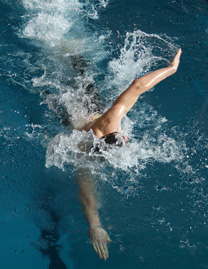
Crédit photo : Manfred Werner
Références de la partie entraînement
D'où viennent les points de côté et comment s'en débarrasser?
Etudes :
(1) Morton DP, Darren P., Callister R., Robin (2000) : Characteristics and etiology of exercise-related transient abdominal pain
(2) Morton DP, Aragon-Vargas LF, Callister R. (2004) : Effect of ingested fluid composition on exercise-related transient abdominal pain.
(3) Morton DP (2003) : Exercise related transient abdominal pain
Livres :
Sport, Santé et préparation physique de Thierry Maquet et Rachid Ziane aux éditions Amphora.
Liens externes :
Exercise related transient abdominal pain: a case report and review of the literature
Comment reconnaître le surentraînement?
Etudes :
(1) A. Schwitzguébel et coll. (1999) : Épidémiologie du syndrome de surentraînement chez le sportif : étude pilote sur 176 sportifs amateurs et professionnels
(2) Fry RW, Morton AR, Keast D. (1991) : Overtraining in athletes. An update.
(3) Eichner (1995) : Overtraining: Consequences and prevention
Livres :
Jack H. Wilmore, DL. Physiologie du sport et de l'exercice, Editions De Boeck
Jürgen Weineck, Manuel d'entraînement, Editions Vigot
Liens externes :
Le surentraînement détection et prévention
Proposition d'un protocole pour le dépistage du surentraînement
Pourquoi nager en amplitude?
SCOTT P. MCLEAN et coll (2010) : Oxygen Uptake Response to Stroke Rate Manipulation in Freestyle Swimming
S'alimenter avant une compétition
Etudes :
(1) Hawley et coll. (1996) : Effects of 3 days of carbohydrate supplementation on muscle glycogen content and utilisation during a 1-h cycling performance
(2) Pitsiladis et coll. (1996) : Effects of alterations in dietary carbohydrate intake on running performance during a 10 km treadmill time trial
(3) Rauch et al. (1995) : The effects of carbohydrate loading on muscle glycogen content and cycling performance
Livres :
(4) Docteur Stéphane Cascua et Véronique Rousseau. Alimentation pour le sportif, Editions Amphora
Denis Richet. Micronutrition, Santé et performance, Editions De Boeck
Le stress est-il favorable à la performance sportive ?
(1) Yuri L. Hanin (1995) : Sport psychology: An analysis of athlete behavior
Livres :
Marylène Pia Gérer la pression en compétition, Editions Amphora
Liens externes :
Le stress : ennemi ou ami de la performance sportive ?
Nutri-site.com, Dossier préparation mentale : Comment gérer son stress ?
L'échauffement avant la compétition
Etudes :
Zochowski, T., Johnson, E., & Sleivert, G. G. (2007) : LONG DELAYS AFTER A WARM-UP REDUCE ITS BENEFITS
Houmard JA, Johns RA, Smith LL, Wells JM, Kobe RW, McGoogan SA (1991) The effect of warm-up on responses to intense exercise.
Article :
Pascal Prévost : L'échauffement, une nouvelle approche
Le poids de l'efficacité
Etudes :
(1) Margaria, R., Cerretelli, P., Aghemo, P. and Sassi, G.(1963). Energy cost of running. J. Appl. Physiol.18, 367-370. ( http://jap.physiology.org/content/18/2/367.short )
(2) Capelli, C.; Pendergast, D.; Termin, B. (1998). Energetics of swimming at maximal speeds in humans. Eur. J. Appl. Physiol., 78, 385-393.
(3) Toussaint HM. (1990) Differences in propelling efficiency between competitive and
triathlon swimmers. Med Sci Sports Exerc. 1990 Jun;22(3):409-15.
La production énergétique
Etudes :
(1) J. R. Lacour,E. Bouvat, J. C. Barthélémy (1990) Post-competition blood lactate concentrations as indicators of anaerobic energy expenditure during 400-m and 800-m races. ( http://link.springer.com/article/10.1007/BF00357594 )
(2) Mujika I, Chatard JC, Lacoste L, Barale F, Geyssant A. (1996). Creatine supplementation does not improve sprint performance in competitive swimmers. http://www.ncbi.nlm.nih.gov/pubmed/8933496
Faut-il faire des séries de battements?
Etudes :
(1) F. Caputo et al. (2006) Intrinsic factors of the locomotion energy cost during swimming. http://www.scielo.br/scielo.php?pid=s1517-86922006000600019&script=sci_arttext&tlng=en
(2) I. Holmér (1974) Propulsive efficiency of breaststroke and freestyle swimming. ( http://link.springer.com/article/10.1007/BF00449511 )
(3) I. Holmér (1974). Energy cost of arm stroke, leg kick, and the whole stroke in competitive swimming styles. http://link.springer.com/article/10.1007/BF00449512
(4) Chatard JC, Lavoie JM, Lacour JR. (1991) Energy cost of font-crawl swimming in women.
(5) Adrian MJ, Singh M, Karpovich PV (1966) Energy cost of leg kick, arm stroke, and whole crawl stroke http://jap.physiology.org/content/21/6/1763.extract
(6) Deschodt VJ et Al. (1999) Relative contribution of arms and legs in humans to propulsion in 25-m sprint front-crawl swimming
Combien de calories brûlez-vous en nageant?
Etudes :
(1) F. Caputo et al. (2006) Intrinsic factors of the locomotion energy cost during swimming. http://www.scielo.br/scielo.php?pid=s1517-86922006000600019&script=sci_arttext&tlng=en
(2) Capelli, C.; Pendergast, D.; Termin, B. (1998). Energetics of swimming at maximal speeds in humans. Eur. J. Appl. Physiol., 78, 385-393.
(3) Chatard JC, Lavoie JM, Lacour JR. (1990) Analysis of determinants of swimming economy in front crawl. http://link.springer.com/article/10.1007/BF00236699
(4) Zamparo P1, Dall'ora A, Toneatto A, Cortesi M, Gatta G. (2012) The determinants of performance in master swimmers: a cross-sectional study on the age-related changes in propelling efficiency, hydrodynamic position and energy cost of front crawl. http://www.ncbi.nlm.nih.gov/pubmed/22426578
S'entraîner en hypoxie, est-ce utile?
Etudes :
(1) Kapus J., Kapus V., Usaj A. (2010) Some metabolic responses to reduced breathing frequency during constant load exercise. http://bmsi.ru/doc/728f92a1-2488-4303-ab11-dce96535e582
(2) Town G P, Vanness JM (1990). Metabolic responses to controlled frequency breathing in competitive swimmers.
(3) Truijens MJ, Toussaint HM , Dow J , Levine BD (2003) Effect of high-intensity hypoxic training on sea-level swimming performances. http://jap.physiology.org/content/94/2/733
Les crampes, peut-on s'en débarasser?
Etudes :
(1) Schwellnus et al. (2011). Increased running speed and previous cramps rather than dehydration or serum sodium changes predict exercise-associated muscle cramping: a prospective cohort study in 210 Ironman triathletes. https://www.ncbi.nlm.nih.gov/pubmed/21148567
(2) P. Edouard (2014) Crampes musculaires associées à l’exercice : discussion sur les causes, la prévention et le traitement, revue Science & Sports Volume 29 https://www.sciencedirect.com/science/article/pii/S0765159714001026
(3) Schwellnus et al. (1997) Aetiology of skeletal muscle 'cramps' during exercise: a novel hypothesis https://www.ncbi.nlm.nih.gov/pubmed/9232553



